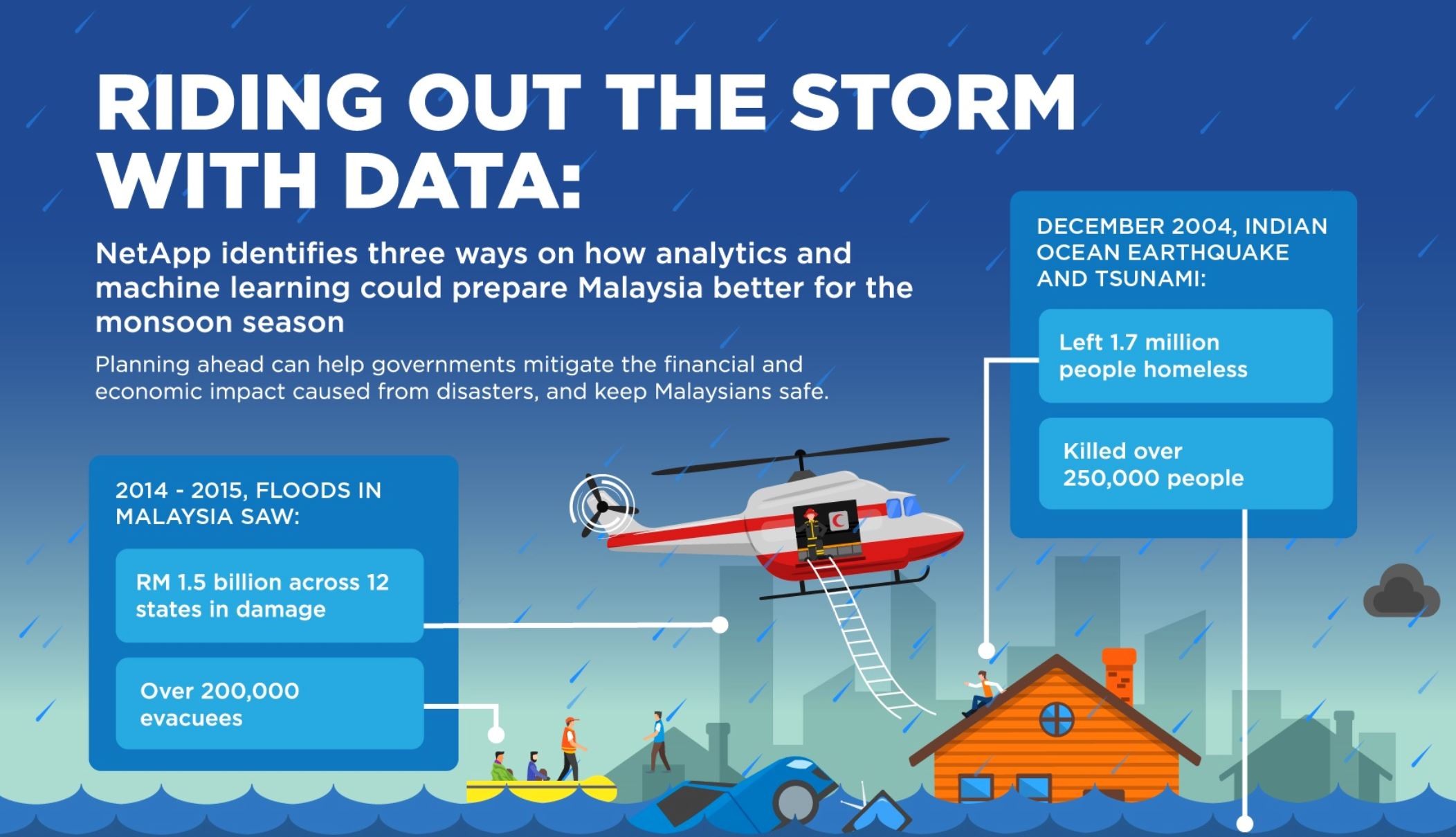The massive tsunami affecting the entire region on 26 December 2004 killed over 250,000 people in a single day and left 1.7 million homeless around the region. Most recently, the 2014-2015 floods in Malaysia saw damages exceeding RM1.5 billion across 12 states and more than 200,000 evacuees during its most critical period.
Both occurred during the infamous Northeast Monsoon (Nov to March) season. While this is traditionally a common annual occurrence in Malaysia and South East Asia, extreme weather resulting from climate change has caused the Monsoon Season to carry far more devastating consequences to the economy and human lives over the past decade.

So, what can the government do to plan ahead, mitigate the impact of the financial and economic damage as the storm hits and most importantly, keep our citizens safe?
The answer lies in better weather and climate forecasting and NetApp has identified three (3) key ways how this can be more accurate with data technology :
1. Bringing Machine Learning to Conventional Weather Models
Weather and climate models are at the heart forecast and prediction. In fact, supercomputers have played a major role in enabling predictive models since the 1950s. Beyond predictions, it is also used to recreate historical data and develop more accurate future analysis.
Today, machine learning (ML) has been added to the mix, further improving accuracies and reducing over reliance on traditional models of the atmosphere, which are more prone to chaotic variables and inconsistencies.
The US National Oceanic and Atmospheric Administration (NOAA) for example, has been using machine learning and AI techniques along with a physical understanding of the environment. This has broadened its predicting accuracy for multiple types of high-impact weather that includes severe thunderstorms, tornadoes, and hurricanes.
In South East Asia, improved predictive models have allowed scientists to discover delays in the start of the monsoon season by up to 15 days over the past few decades. In fact, it has also resulted in the ability to further understand when extreme weather incidences are likely to occur during the monsoon season. For example, countries closer to the equator, such as Malaysia and Singapore, experience rain and drought in a 10-year cycle; whereas countries further north such as Philippines and Thailand experience a 30-year cycle instead.
The greater accuracy and consistency provided by machine learning will enable government departments within South East Asian countries to work together towards a more collaborative disaster preparedness and recovery while also optimising investment in risk mitigation infrastructure and technologies.
2. Optimising the use of Enormous Data Sets for Faster Real-Time Insights
The scope of the weather-related data available is positively massive. There are over a thousand weather satellites in space currently providing a wealth of data about cloud patterns, winds, temperatures and more. These satellites are only a small part of the data production taking place. There are hundreds of thousands of government and private weather stations on Earth, constantly gathering real-time data.
These are also increasing exponentially, placing great demand on the infrastructure to transport, manage, and store this data, and requiring ever-greater computational power for simulations that use it. Done right, these large amounts of data can be optimised to provide real-time updates or hone early warning systems, saving countries a large amount of money and time.
The Indian Meteorological Department for example has been able to improve forecast on the arrival of its monsoon season from just fifteen days previously, to three months this year, thanks to adopting a more sophisticated predictive model with real-time data analytics at the core. This provided enough time for Indian farmers to sow their seeds and plan for alternative irrigation resources and for civic authorities to effectively plan the distribution of water for domestic and industrial uses during the difficult season.
Taking these learnings, Malaysian meteorological department and agencies should also began adopting technologies and solutions that will enable them to process weather data faster, before a monsoon flood or storm hits.
Furthermore, big data analytics already forms a significant part of the national agenda in Malaysia, Indonesia and Thailand, becoming more instrumental in a wide range of government projects and industries. Therefore, it wouldn’t be a stretch to apply these same principles and key learnings to weather forecasts.
For example, the Thailand Meteorological Department has invested in technologies that allow it forecast weather more than seven days in advance, by month or by season while also garnering intelligence that allows it to better protect its people against related natural disasters in the future.
3. Solving Critical Geographical Challenges
Beyond managing the immediate effects of the monsoon season, data technologies can also be used to solve other critical geographical challenges. Satellite and radar imagery, surface observations, along with measurements of barometric pressure, wind speed, precipitation, temperature, and humidity all create pictures of the extent of long-term weather damage, which could be used to inform policies and infrastructure development.
For example, one of the key impacts of the 2004 tsunami was the erosion of coastal land in South East Asian countries. To prevent further damage in the future, coastal engineers can use wind and wave climate data to preserve the marine ecosystem and prevent beaches from eroding. They do this by building statistical models that predict wave activity, or hydrodynamic impact.
As a result, they can identify where to place breakwaters and seawalls, dredge sand, mud, and rocks away or move them to another location. In addition, they can create artificial dunes to hold an eroding shoreline in place; protecting beautiful South East Asian beaches for tourism and more.
South East Asian Governments and companies invest billions of dollars into weather forecasting every year for good reason. There is effectively no sector of the economy which is not directly or indirectly impacted by the weather.
The potential source of weather-related data will continue to grow dramatically and the new advances in analytics, AI and machine learning are making it possible for government agencies and companies to make better use of all this data.
At NetApp, we are excited to be a part of this continuing improvements. NetApp® All Flash FAS solution for example, has enabled organisations to deliver the performance needed to speed up data visualisation for weather forecasters around the world. This is something NetApp is excited to share in South East Asia, in the 2018 monsoon season and beyond.
-End-
About NetApp
NetApp is the data authority for hybrid cloud. We provide a full range of hybrid cloud data services that simplify management of applications and data across cloud and on-premises environments to accelerate digital transformation. Together with our partners, we empower global organisations to unleash the full potential of their data to expand customer touchpoints, foster greater innovation and optimise their operations. For more information, visit www.netapp.com. #DataDriven #DataFabric
For more information, please visit www.netapp.com








